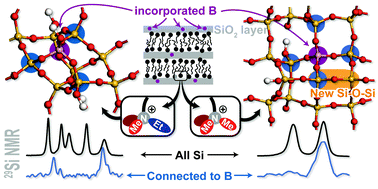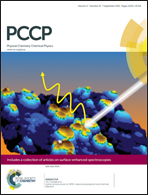Local environments of boron heteroatoms in non-crystalline layered borosilicates†
Abstract
Boron heteroatom distributions are shown to be significantly different in two closely related layered borosilicates synthesized with subtly different alkylammonium surfactant species. The complicated order and disorder near framework boron sites in both borosilicates were characterized at the molecular level by using a combination of multi-dimensional solid-state nuclear magnetic resonance (NMR) spectroscopy techniques and first-principles calculations. Specifically, two-dimensional (2D) solid-state J-mediated (through-bond) 11B{29Si} NMR analyses provide direct and local information on framework boron sites that are covalently bonded to silicon sites through bridging oxygen atoms. The resolution and identification of correlated signals from distinct 11B–O–29Si site pairs reveal distinct distributions of boron heteroatoms in layered borosilicate frameworks synthesized with the different C16H33N+Me3 and C16H33N+Me2Et structure-directing surfactant species. The analyses establish that boron atoms are distributed non-selectively among different types of silicon sites in the layered C16H33N+Me3-directed borosilicate framework, whereas boron atoms are preferentially incorporated into incompletely condensed Q3-type sites in the C16H33N+Me2Et-directed borosilicate material. Interestingly, framework boron species appear to induce framework condensation of their next-nearest-neighbor silicon sites in the C16H33N+Me3-directed borosilicate. By comparison, the incorporation of boron atoms is found to preserve the topology of the C16H33N+Me2Et-directed borosilicate frameworks. The differences in boron site distributions and local boron-induced structural transformations for the two surfactant-directed borosilicates appear to be due to different extents of cross-linking of the siliceous frameworks. The molecular-level insights are supported by density functional theory (DFT) calculations, which show the distinct influences of boron atoms on the C16H33N+Me3- and C16H33N+Me2Et-directed borosilicate frameworks, consistent with the experimental observations.


 Please wait while we load your content...
Please wait while we load your content...